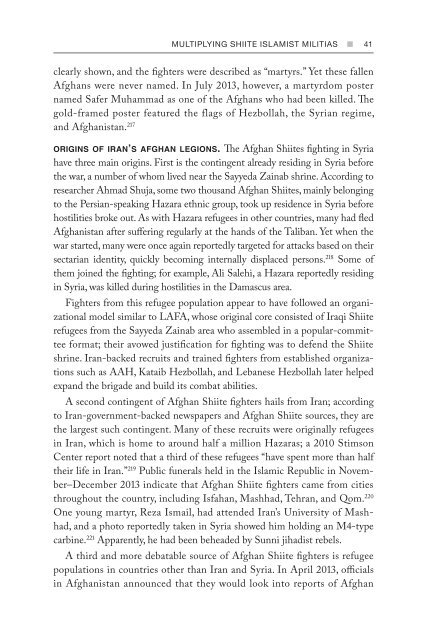You also want an ePaper? Increase the reach of your titles
YUMPU automatically turns print PDFs into web optimized ePapers that Google loves.
MULTIPLY<strong>IN</strong>G <strong>SHIITE</strong> ISLAMIST MILITIAS n 41<br />
clearly shown, and the fighters were described as “martyrs.” Yet these fallen<br />
Afghans were never named. In July 2013, however, a martyrdom poster<br />
named Safer Muhammad as one of the Afghans who had been killed. The<br />
gold-framed poster featured the flags of Hezbollah, the Syrian regime,<br />
and Afghanistan. 217<br />
origins of iran’s afghan legions. The Afghan Shiites fighting in Syria<br />
have three main origins. First is the contingent already residing in Syria before<br />
the war, a number of whom lived near the Sayyeda Zainab shrine. According to<br />
researcher Ahmad Shuja, some two thousand Afghan Shiites, mainly belonging<br />
to the Persian-speaking Hazara ethnic group, took up residence in Syria before<br />
hostilities broke out. As with Hazara refugees in other countries, many had fled<br />
Afghanistan after suffering regularly at the hands of the Taliban. Yet when the<br />
war started, many were once again reportedly targeted for attacks based on their<br />
sectarian identity, quickly becoming internally displaced persons. 218 Some of<br />
them joined the fighting; for example, Ali Salehi, a Hazara reportedly residing<br />
in Syria, was killed during hostilities in the Damascus area.<br />
Fighters from this refugee population appear to have followed an organizational<br />
model similar to LAFA, whose original core consisted of Iraqi Shiite<br />
refugees from the Sayyeda Zainab area who assembled in a popular-committee<br />
format; their avowed justification for fighting was to defend the Shiite<br />
shrine. Iran-backed recruits and trained fighters from established organizations<br />
such as AAH, Kataib Hezbollah, and Lebanese Hezbollah later helped<br />
expand the brigade and build its combat abilities.<br />
A second contingent of Afghan Shiite fighters hails from Iran; according<br />
to Iran-government-backed newspapers and Afghan Shiite sources, they are<br />
the largest such contingent. Many of these recruits were originally refugees<br />
in Iran, which is home to around half a million Hazaras; a 2010 Stimson<br />
Center report noted that a third of these refugees “have spent more than half<br />
their life in Iran.” 219 Public funerals held in the Islamic Republic in November–December<br />
2013 indicate that Afghan Shiite fighters came from cities<br />
throughout the country, including Isfahan, Mashhad, Tehran, and Qom. 220<br />
One young martyr, Reza Ismail, had attended Iran’s University of Mashhad,<br />
and a photo reportedly taken in Syria showed him holding an M4-type<br />
carbine. 221 Apparently, he had been beheaded by Sunni jihadist rebels.<br />
A third and more debatable source of Afghan Shiite fighters is refugee<br />
populations in countries other than Iran and Syria. In April 2013, officials<br />
in Afghanistan announced that they would look into reports of Afghan


